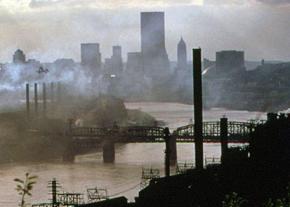Murders in--and of--the Steel City
reviews a mystery novel set in Pittsburgh, both past and present day.
AREN'T THERE enough murder mysteries in the world?
Of course not! And here comes yet another must-read page-turner, with a twist that may draw in some not necessarily addicted to the genre.
From the very first page, there is a cascade of suspenseful events illuminating a web of interweaving mysteries, all solved by the final page. Animated by two strong heroines, their story comes to life through their interplay with a cast of likable characters, richly varied by race, class, gender, cultural styles--not to mention personalities.
There is also an ample supply of satisfyingly detestable villains. It is, at one and the same time, a fast-paced swirl of politics, class-conflict and murder. (If my math is right, there are actually four murders.) What's not to like?
The setting is the Pittsburgh area at two points in time: the late 1970s, when three of the murders take place, and the same scene three decades later. The central character of the 1970s is Ginny, a spunky steelworker carrying on the radical labor tradition of her grandfather who had been active in the Industrial Workers of the World.

The central character of 2007 is her daughter Cory. With the same red hair and spirit of the mother she never knew, she tries to unravel the mystery of Ginny's disappearance.
THE FOCAL point of the book is the steel industry.
What made Pittsburgh the Steel City was the dense network of factories not only within the city limits but also running around the city and through the Mon Valley--now part of the famed "Rustbelt," but then vibrant powerhouses of profits and pollution. The mills supplied good-paying jobs (thanks to militant workers' struggles of the 1930s and '40s) that sustained innumerable working-class families and their communities.
The workers are the heart and soul of this book, and their communities and workplaces provide the landscape: Braddock, Homestead, Munhall, Rankin--with all the appropriate streets, highways and bridges (bars and diners, too).
In fact, the impending murder of the Pittsburgh steel industry is forecast and any mystery solved by Ginny herself halfway through the novel. And she doesn't hesitate to let the cat out of the bag at a union meeting, where she confronts a "partners-in-progress" steel company executive, who had been invited by the bureaucratic-conservative union leadership to "explain" things to the workers.
Those interested in the "nothing-but-the fact" details can consult John Hoerr's And the Wolf Finally Came: The Decline and Fall of the American Steel Industry. But let's listen to Ginny taking the floor at her union meeting:
Right now American Steel has 150,000 steelworkers on its payroll. In the next few years they plan to send 95,000 of us to the unemployment lines permanently. They are going to downsize us...
You, Regina, you can forget about buying that little house you want for you and your kids. And you, Frankie, can forget about sending your boy to college. Conrad, you can forget about the health insurance that takes care of your sick wife. I can forget about buying a newer car.
Mortgages are going to go into arrears for tens of thousands. There will be long lines around the offices of bankruptcy lawyers. We won't be carrying cash into supermarkets, no sir, we'll be paying with food stamps. That's the future they're planning for us.
The truth is American Steel is moving out of the steelmaking business. They have milked it dry and can't cut a big enough profit...They just bought an oil company for six billion dollars. When they go shopping, it's not the same as you and me. We don't take the food from our children's mouths so that we can go buy a TV, but they do. They take the food from OUR children's mouths so they can buy other industries.
The militant class warrior in Ginny rubs a number of menacing enemies the wrong way--both higher-ups and lower-downs in big steel's corporate structure, of course, but also corrupted and partially rogue elements within the steelworkers union to which Ginny belongs. Not to mention bigots drawn to the Ku Klux Klan.
Some aggressive snooping-around by her daughter Cory, decades later, stirs into action some of the same elements.
Among the sinister undercurrents in the book is a pervasive racism against which this book and its heroines consistently push back, not to mention the taboos--much stronger 30 years ago than now--regarding interracial relationships. The troubled atmosphere is similarly interlaced with substantial dollops of poisonous and violent misogyny--directed especially against our smart and articulate heroines, who don't know enough to "stay in their place."
While I've already spilled the beans on one of the four dastardly acts chronicled in Woman Missing, readers would do well to investigate the rest on their own.
WHO IS responsible for this book? There are two answers--the creator, of course, but also the entity mysteriously transforming manuscripts into books.
There is a strange anomaly--a small independent publisher called Hard Ball Press--which publishes the writings of workers who describe their experience as workers. Some do this in interviews and essays, but others resort to fiction, including publisher Tim Sheard's delightful "Lennie Moss" mystery series (the hero being a hospital worker and union steward specializing in solving murders and related crimes).
This book's author is first-time novelist Linda Nordquist, a clinical social worker (and writer and photographer) living in Rapid City, South Dakota.
But that's now. Before that, she lived in Peru, where she wrote her memoir The Andes for Beginners. And before that, in the late 1970s and early 1980s, she was a steelworker at U.S. Steel's Edgar Thomson Works in Braddock, Pennsylvania--spending a decade that has resulted in this gift of what Ernest Mandel (in his Marxist analysis of the genre) once termed "delightful murders."


